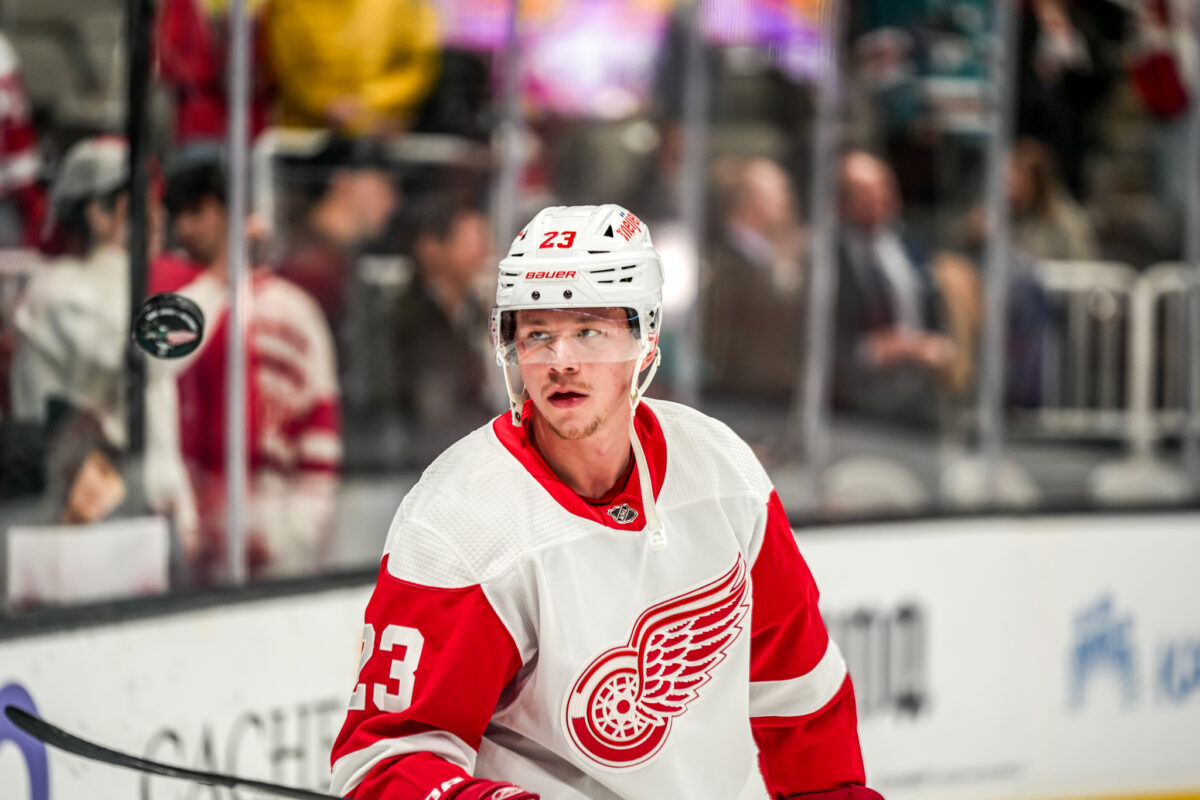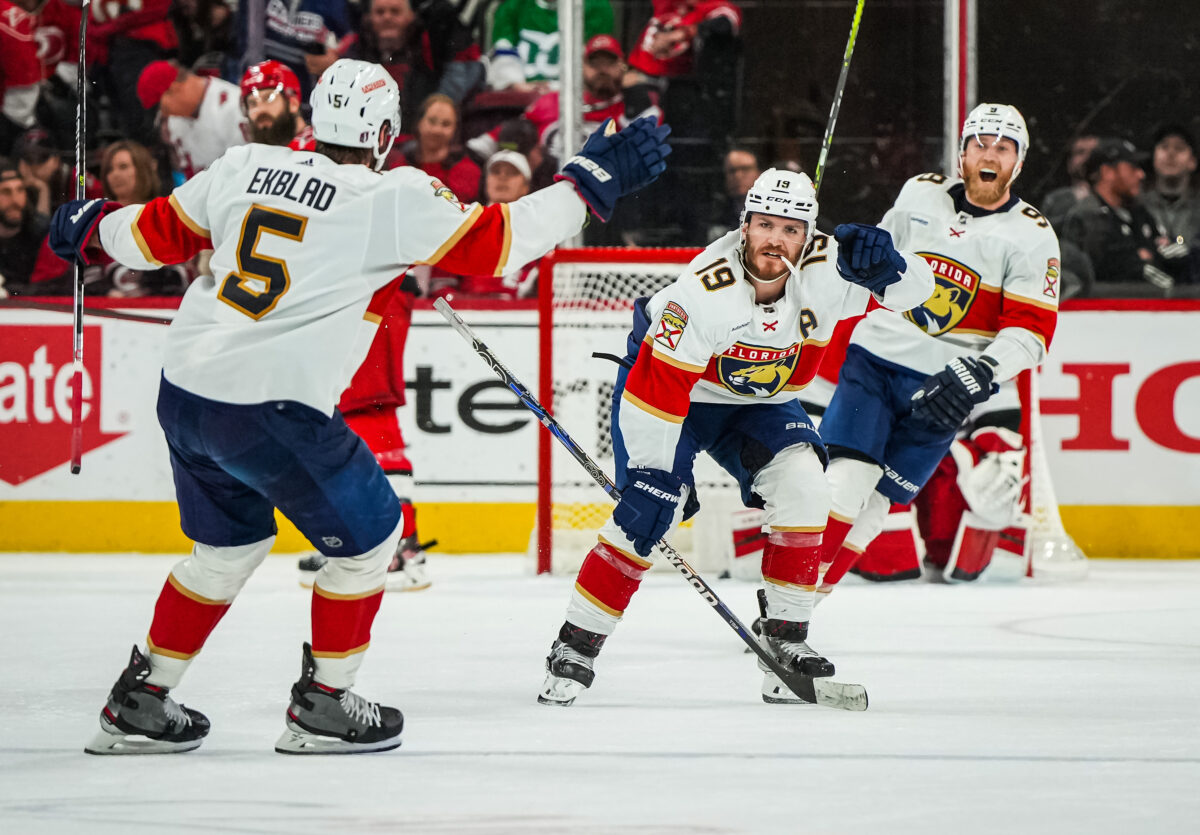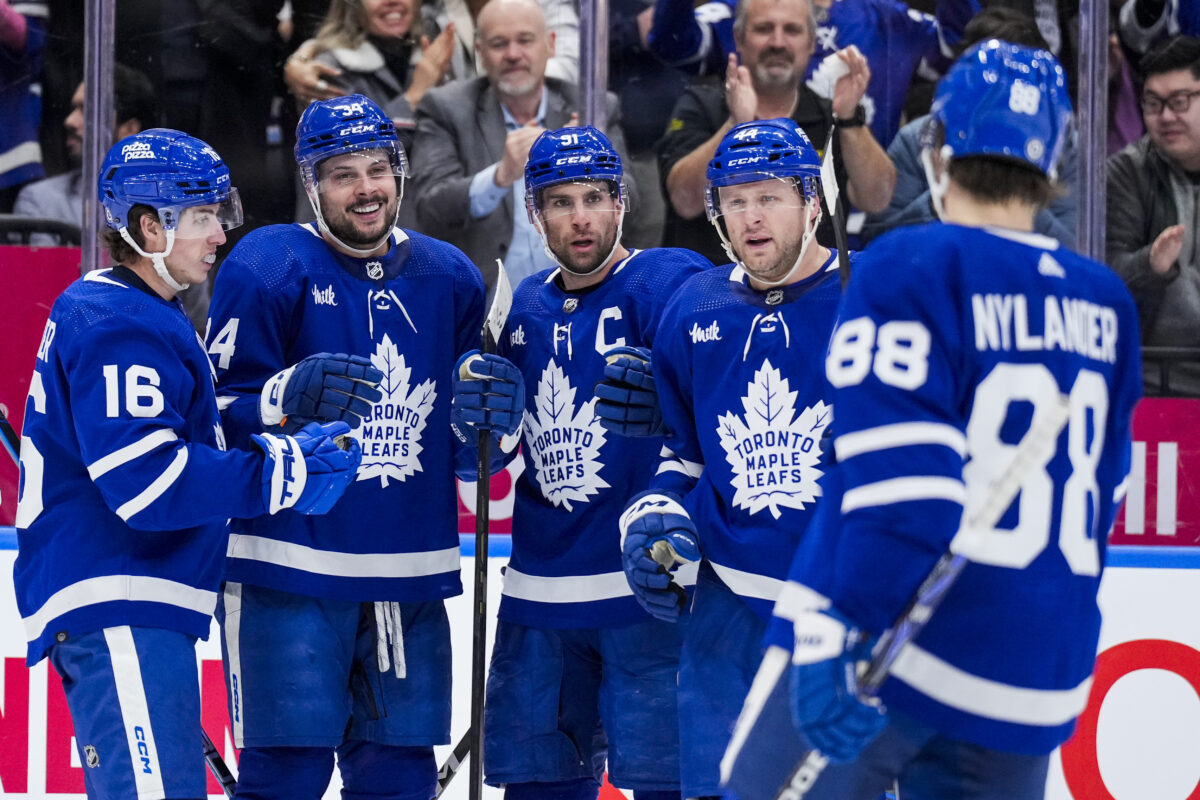The 2024-25 NHL season is finally here; after a long offseason that saw plenty of movement, the Detroit Red Wings see some new faces in the organization. They also have seen a few leave the organization, as is the case for the rest of the league. With the opening night rosters set for all 32 teams, the Red Wings will try to get back into the playoffs with the roster that general manager (GM) Steve Yzerman and head coach Derek Lalonde have decided to go with. But how does it stack up to the rest of the Atlantic Division? We will start by taking a look at the forward group.
How the Red Wings Forward Group Looks
| LW | C | RW |
| Alex DeBrincat | Dylan Larkin | Lucas Raymond |
| Vladimir Tarasenko | JT Compher | Patrick Kane |
| Michael Rasmussen | Andrew Copp | Christian Fischer |
| Tyler Motte | Joe Veleno | Jonatan Berggren |
Yzerman went out in the offseason and brought in a couple of veterans, Vladimir Tarasenko and Tyler Motte. Tarasenko will likely fill the hole left by the departing David Perron (left via free agency to the Ottawa Senators) and should be able to contribute offensively at a higher level than Perron did last season. Motte will be more of a defensive-type forward in the lineup and bring more stability to the penalty kill and defensive zone. The team’s top line of DeBrincat, Larkin, and Raymond will also be looked to for a replication of last season’s production.

With an entire season of Patrick Kane in the lineup, the line of himself, Tarasenko, and Compher will be one to keep an eye on for fans after Compher’s strong play in his first season with the organization last season. Overall, from top-to-bottom, the Red Wings’ lineup has players who can produce offensively.
How the Red Wings Stack Up with the Rest of the Division
Boston Bruins
| LW | C | RW |
| Pavel Zacha | Elias Lindholm | David Pastrnak |
| Brad Marchand | Charlie Coyle | Morgan Geekie |
| Max Jones | Trent Frederic | Justin Brazeau |
| Johnny Beecher | Mark Kastelic | Cole Koepke |
Once again, The Boston Bruins will have a veteran-laden roster this season, led by David Pastrnak and Brad Marchand. GM Don Sweeney brought in Elias Lindholm to help center the top line, which will be relied upon quite a bit this season. When it comes to the top six of the Bruins and Red Wings rosters, there could be a case to be made that it’s pretty even across the board, with the outlier being David Pastrnak, who has continued to dominate with 110 points last season (47 goals, 63 assists). If the Red Wings can get a full season of consistency from players like Alex DeBrincat and Tarasenko, there is a chance that the top six could end up edging out the Bruins, but for now, I’m giving the Bruins a slight edge.
Top-six advantage: Bruins
Where I think the Red Wings have an advantage over the Bruins is when it comes to the bottom-six of the lineup. Boston has a bottom-six with a handful of players who are not necessarily proven or who have brought a ton offensively in the past. The Red Wings have a strong bottom-six with players like Michael Rasmussen and Joe Veleno. The wildcard is Jonatan Berggren. He has shown that he is more than capable of taking advantage of the opportunities the team has given him in the past and could easily be on one of the top two lines if it was not for players like Kane and Lucas Raymond holding down the fort on those lines. If he can continue to take advantage of whatever ice time is given to him, the bottom six that the Red Wings will be deploying could be a vital aspect of the lineup.
Bottom-six advantage: Red Wings
Buffalo Sabres
| LW | C | RW |
| JJ Peterka | Tage Thompson | Alex Tuch |
| Jiri Kulich | Dylan Cozens | Jack Quinn |
| Jordan Greenway | Ryan McLeod | Jason Zucker |
| Beck Malenstyn | Peyton Krebs | Sam Lafferty |
| Zach Benson |
A team that has been compared to the Red Wings in terms of being a rebuilding team over the last handful of seasons, the Buffalo Sabres have built themselves a solid team led up front by Tage Thompson. He had a down season last season, but if he can rebound this season, he will make the Sabres’ offense even more explosive. Along with him on the top line is Alex Tuch, who was the team’s leading point-scorer last season. The Sabres’ top line is close to what the Red Wings have in DeBrincat, Larkin, and Raymond, but I’ll give the edge to the Red Wings.
Related: Comparing the Status of Senators, Sabres & Red Wings Rebuilds
Where things start to tilt more in the Red Wings’ favor is with the second line. While they have a veteran-laden second line, the Sabres are relying on some younger players who are a bit unproven with Jiri Kulich, Dylan Cozens, and Jack Quinn, who, between the three players, have played a total of eight seasons in the league. Both teams have a wildcard at the bottom of their lineups, with Berggren in the Red Wings’ lineup and Peyton Krebs in the Sabres’ lineup. Overall, the Red Wings have a slight edge in the bottom two forward lines.
Advantage: Red Wings
Florida Panthers
| LW | C | RW |
| Carter Verhaeghe | Alexsander Barkov | Sam Reinhart |
| Evan Rodrigues | Sam Bennett | Matthew Tkachuk |
| Eetu Luostarinen | Anton Lundell | Mackie Samoskevich |
| Jonah Gadjovich | Jesper Boqvist | AJ Greer |
The 2024 Stanley Cup champions saw a bit of change to their entire roster but still have a solid forward group after they lost Tarasenko to the Red Wings. They are led by Matthew Tkachuk, a major thorn in the side for the entire league with his play. While he and Aleksander Barkov have been consistent high-level players in the league, they enjoyed a massive breakout season from Sam Reinhart (57 goals). He will likely not replicate that type of season again. The top-six matchup between the two teams will likely be a push.
Top-six advantage: Push

With the bottom six, the Panthers will deploy players who have either not had much success in their careers (AJ Greer, Jonah Gadjovich) or have not had the time to prove themselves quite yet (Mackie Samoskevich). They do have Eetu Luostarinen and Anton Lundell, who were both vital in the team’s Stanley Cup run last season, but overall, the Red Wings seem to be a bit deeper and skilled in the bottom six of the forward lineup.
Bottom-six advantage: Red Wings
Montreal Canadiens
| LW | C | RW |
| Cole Caufield | Nick Suzuki | Juraj Slafkovský |
| Alex Newhook | Kirby Dach | Joel Armia |
| Alex Barré-Boulet | Christian Dvorak | Josh Anderson |
| Brendan Gallagher | Jake Evans | Emil Heineman |
One of the league’s younger teams (average age of 26 years old), the Montreal Canadiens have made strides in their development but are still a step behind the rest of the Atlantic Division. Up front, they have a handful of young players who can be top-level players (Cole Caufield, Nick Suzuki, Juraj Slafkovský). Kirby Dach has the chance to really prove himself this season after being injured for most of last season and could help take the Canadiens’ offense to the next level. But overall, the Red Wings, at this point, have a stronger overall forward grouping that has more established and proven players in it.
Advantage: Red Wings
Ottawa Senators
| LW | C | RW |
| Brady Tkachuk | Tim Stützle | Claude Giroux |
| Ridly Greig | Josh Norris | Drake Batherson |
| David Perron | Shane Pinto | Michael Amadio |
| Noah Gregor | Adam Gaudette | Nick Cousins |
A team that has been a massive thorn in the Red Wings’ side, led by Brady Tkachuk, the Ottawa Senators forward grouping is comparable to the Red Wings. Both teams have a mix of veterans and younger players in their lineup, and they have enough skill to help spread the offense through all four lines. The biggest question for the Senators is if Josh Norris can stay healthy. The five-year pro has struggled to do so during his career but has continued showing flashes of top-level offensive skill. The Senators and Red Wings forward groups are alike in many ways, which makes this a push for who has the advantage.
Advantage: Push
Tampa Bay Lightning
| LW | C | RW |
| Jake Guentzel | Brayden Point | Nikita Kucherov |
| Brandon Hagel | Anthony Cirelli | Conor Sheary |
| Conor Geekie | Nick Paul | Cam Atkinson |
| Zemgus Girgensons | Luke Glendening | Michael Chaffee |
| Michael Eyssimont |
Even after losing their long-time captain, Steven Stamkos, who left for the Nashville Predators this offseason, the Tampa Bay Lightning still possess one of the strongest top lines in the entire league. They “replaced” Stamkos with Jake Guentzel to pair up with Brayden Point and Nikita Kucherov. The top line holds the advantage over the top line the Red Wings will likely have this season. The Lightning’s second line is also strong enough to complement the top line very well.
Top-six advantage: Lightning
While the group is getting older, they continue to produce at a high level. The most significant question mark is how the bottom six will produce. They did bring in veteran Cam Atkinson this offseason, and Conor Geekie earned himself a spot in the lineup after being acquired from the Utah Hockey Club. With it being Geekie’s first NHL season and the rest of the projected bottom six combining for 57 points (Eyssimont included), the edge for the bottom six goes to the Red Wings.
Bottom-six advantage: Red Wings
Toronto Maple Leafs
| LW | C | RW |
| Matthew Knies | Auston Matthews | Mitch Marner |
| Max Domi | John Tavares | William Nylander |
| Max Pacioretty | Pontus Holmberg | Nick Robertson |
| Steven Lorentz | Michael Kampf | Ryan Reaves |
When part of a team’s “Core 3” is one of, if not the best, pure goal scorers in the league, your offensive group will also be one of the best. With Auston Matthews leading the way and Mitch Marner and William Nylander helping out up front, the Toronto Maple Leafs have one of the league’s highest-powered offenses. On top of that, the question marks surrounding Marner’s future with the team beyond this season could easily lead to him proving that he deserves to be paid the money he believes he does with a strong season. The top-six of the Maple Leafs have more firepower than the Red Wings, leading to them getting the advantage here.
Top-six advantage: Maple Leafs

One big question mark for the Maple Leafs bottom-six this season is how Max Pacioretty looks. He is 35 years old and has fought injuries the past couple of seasons but earned himself a contract with the Maple Leafs after the preseason. If he and Nick Robertson can provide secondary scoring, the team will have at least a third line that matches the Red Wings. It seems the Red Wings have an advantage with the fourth line they possess. Neither Steven Lorentz nor Ryan Reaves produced a lot last season and will likely be relied upon more as players who will give the top lines a break when needed.
Bottom-six advantage: Red Wings
Red Wings’ Forward Group Has High Expectations
With the development and play of the forwards returning to the Red Wings roster this season, along with a couple of additions, there are high hopes and expectations for this group. The team has a chance to make some noise and fight its way to a playoff spot.
